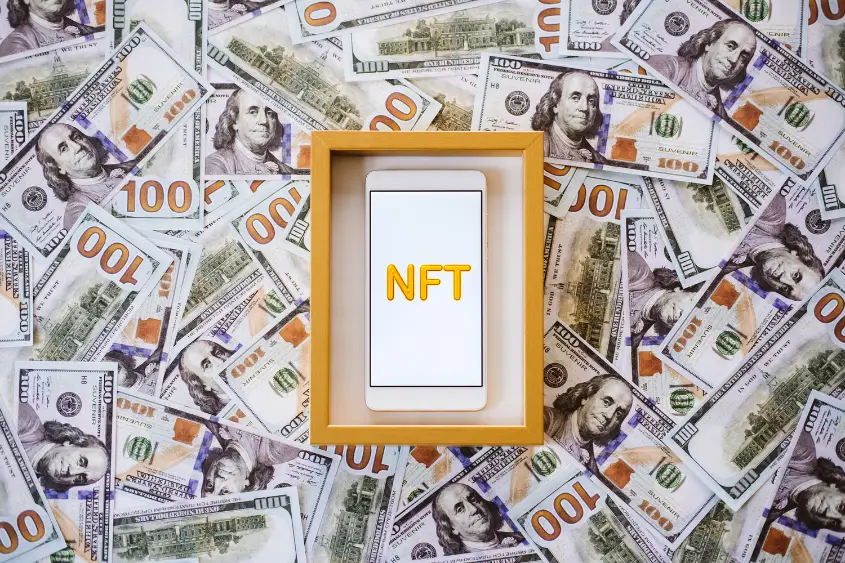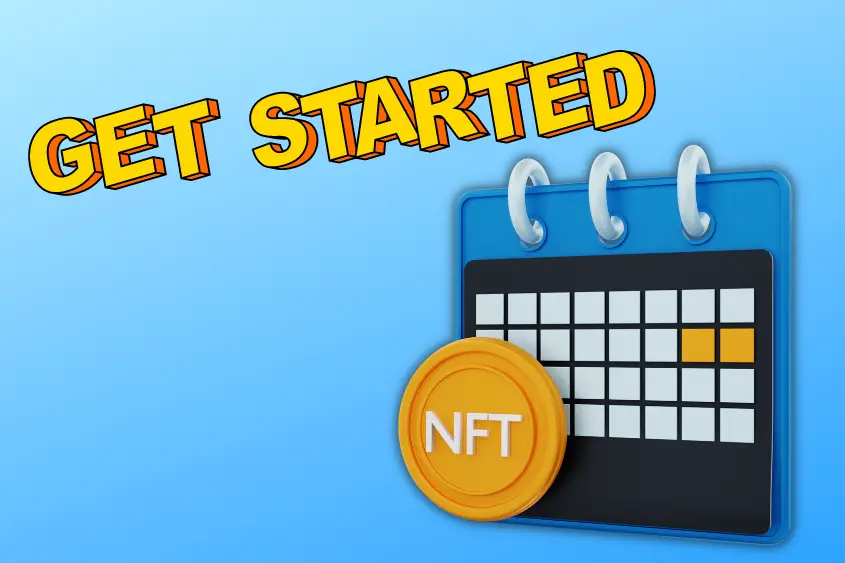NFTs seemingly appeared out of nowhere as expensive digital pieces of art. Now the technology is finally being seen for its true potential. But is it too late to get into NFTs?
It’s not too late to get into NFTs, the technology is still in its infancy. It will likely take at least another 10 years for the world to fully adopt the technology, and 15 years before it is optimized entirely. If you want to get into NFTs, now is the perfect time to get started.
If you have recently discovered NFTs or your curiosity has just now been sparked, you’re probably wondering what all you’ve missed and if it’s too late to get started? In this article, I’m going to prove to you just how early it still is.
Why It’s Still Early for NFTs
Considering NFTs began to gain traction in 2021, it is still very early in the evolution and adoption of the technology. In comparison, mass adoption of social media took about 23 years (1997 to 2020). In fact, influencer marketing wasn’t a thing until 13 years after social media’s initial introduction.

The opportunity in Web 2.0 (the social media era) from 2005 to 2020 was extraordinary. Facebook (2004), Spotify (2006), Uber (2009), Instagram (2010), and TikTok (2016) are prime examples of how long it actually took for society to adopt and develop platforms based on the technology.
To better understand just how early you are to the NFT space, let’s take a stroll down memory lane. Below is a brief timeline of NFT adoption up to now.
2014 to 2020
At this stage, NFTs were only known by an extremely small niche group of individuals. Most of the people involved in NFTs this early on were developers and some investors.
The first known NFT was created in May 2014. From 2014 to 2020, there were a lot of significant developments which ultimately led up to the 2021 boom.
Rare Pepes are among some of the first-ever NFTs sold. These meme-inspired NFTs were first sold on a peer-to-peer marketplace called Counterparty, built on top of the Bitcoin blockchain.
This ended up being the first-ever crypto art marketplace.
It wasn’t until 2020 that the Ethereum Emblem Vault created a way to allow traders to wrap their Pepe NFTs inside an ERC-721 token to transfer and sell it using Ethereum-compatible wallets.
For that reason, I believe Rare Pepes have not been as popular as the famous CryptoPunks.
CryptoPunks was launched in 2017. However, shortly after the launch, a bug was discovered in the smart contract that allowed buyers to have their ETH refunded. As a result, Larva Labs created an amended contract that was later airdropped to holders. These V2 Punks are now considered the “official” CryptoPunks.
Surprisingly, 9,000 CryptoPunks were actually given away for free to anyone who has an Ethereum wallet at the time of the project’s release. Now they sell for hundreds of thousands to millions of dollars.
Keep in mind that all of this occurred in the background between 2014 to 2020 before anyone knew about NFTs. That just goes to show how early the technology really is.
2021 to Current
It wasn’t until 2021 that NFT technology really started to gain some mainstream recognition. Early on in 2021, NFTs were known by most as digital pieces of art. This is largely due to Beeple’s $69 million sale of his NFT art.

Of course, this made headlines all around the world, and Beeple (Mike Winklemann) instantly became the third most valuable living artist.
From then on, thousands of creators began to flow into the NFT space. Mainly artists and people looking to make a quick buck on this newfound digital gold rush.
Eventually, there were hundreds of new projects being released on a daily basis, and many of them would sell out. Nowadays, this isn’t the case. And that’s probably one of the reasons why you’re here reading this article.
It didn’t take long for people to start questioning what value NFTs actually provided beyond an image on the screen. After every type of animal known to man had been used to create the next-best 10,000-piece profile picture project (PFP), sales started to decline.
Also, that’s why it has been said over and over again that 98% of NFTs created during the hype phase will fall to $0. Still, NFT sales volume totaled nearly $25 billion in 2021 alone. That being said, Jefferies (an investment banking company) estimates that the NFT market cap could exceed $80 billion by 2025.
2021 will forever be known as the rise of collectible NFTs with little-to-no utility. As we continue to progress, we are just now beginning to see NFTs with much more utility, and little-to-no collectibility.
That’s because before something can really be considered a collectible, people have to value it first—and value is determined by demand.
That’s how early the NFT industry is. We’re just now figuring out how to apply something that we’ve known for years. Hence why it’s going to take time for NFTs to penetrate mass scale.
Are NFTs Still Worth Getting Into?
NFTs are worth getting into if you are interested in the technology and what it offers. They can provide you with instant value via utility and act as a source of income or an investment; among many other things. Ultimately, if you find any value if NFT technology, it’s worth learning more about.

Below are reasons why you should consider getting into NFTs.
We are living in a digital landscape
Now more than ever, we are living in a digital landscape. As society becomes more digital, the things we value change. What did followers and blue checkmarks mean to us 20 years ago? Not a whole lot. Now, people will do almost anything to gain followers and only dream of having a blue checkmark.
But, why? Social currency, that’s why.
It’s human nature to express ourselves and communicate with each other through the things we have. Posting an image of yourself wearing a Rolex or posing next to your fancy car is no different than flexing a hundred thousand dollar NFT as your profile picture.
Humans will continue to evolve. There’s no avoiding it. We value NFTs and have already shown it’s part of our evolution, just like we’ve evolved to value certain brands, and our follower counts on social media.
At this point, there’s no denying that NFTs are simply another way to communicate who we are as individuals. This will continue to reign true for years to come.
Brand is relevant now more than ever
For centuries, it’s been about brand. Brand is the reason you buy what you buy. Whether it be your pair of Nikes or your Starbucks coffee, brand plays a huge role in what we buy and why we value it over something similar.

NFTs are also brand, and brand isn’t going anywhere anytime soon. In fact, brand is only going to matter more in the future. So when Nike and Starbucks decide to launch their own NFT (they already have), what do you think their loyal customers are going to do? Support them, that’s what.
Once all the big-name brands implement NFTs (many already have), everyone will own an NFT. It might be as simple as something like a receipt, or something exciting like a concert ticket. That being said, we aren’t quite there yet.
Why? Because we’re still early.
NFTs provide society with unseen levels of transparency
NFTs also bring something new to the table. Something that we’ve never quite had before. That is—complete transparency. Thanks to NFTs being built on top of blockchain technology (a digital, public ledger), we now have the ability to view anyone’s transactions and authenticate every asset.
Before, you could take a picture of a rental car and claim it was yours. Now, there’s no hiding it. Eventually, everything will be stored on the blockchain for everyone’s convenience and safety. And when you need to verify something is true, you will simply check the blockchain.
Considering the technology is available, I’m a firm believer that this transparency will be utilized by every industry, in the future.
Underlying smart contract technology will impact every industry
The underlying smart contract technology is still so underrated and unexplored. The moment that society understands how to utilize this technology to its full potential will be the moment NFTs have their greatest impact. Until then, we continue to innovate and push the limits.

In 5 to 10 years, there will be no reason for a concert house or airline to provide you with a physical ticket stub. Instead, it will be an NFT. We’ve already transitioned from paper slips to QR codes, it only makes sense that NFTs are the next step.
Smart contracts have already been used to access conferences such as Veecon, and to contractually receive physical products upon the purchase of NFTs (VeeFriends Compete and Collect Cards).
Eventually, NFTs will take the place of home deeds and other physical contracts. Once we can figure out the legalities behind smart contract technology, things will get very interesting very fast. But again, these things take time.
Creator royalties have yet to be fully implemented
Royalty fees can be written into a smart contract to deploy a payment to the creator of the NFT every time it is sold on the secondary market. Before NFTs, this was not impossible, but it was hardly ever executed well.
Creators deserve to be paid for their work especially if others are still wanting to buy it, even if it’s years later. Furthermore, royalty fees are distributed automatically by the smart contract built-in to the NFT. This means there’s no need for intermediaries, it’s all done automatically for you.
We’ve just barely begun to scratch the surface of royalties. This is something many brands will eventually utilize more often.
Derivative asset creation has yet to be seen
NFTs provide brands the opportunity to create derivative assets. For example, say your local coffee shop partners with a local artist to design a limited edition NFT membership card that’s valid for 1 year.

Not only does this membership card provide holders with exclusive offers and discounts, but it’s also a collectible piece of art. Now, say that artist happens to become extremely well known over the next 5 years.
Even though the membership has expired and holders lost their coffee shop perks, they still own the NFT. This means they own an original piece of art from this now-famous artist. Holders could then sell this asset for a nice profit
And since the coffee shop decided to implement royalty fees (5% to the shop and 5% to the artist), they both make a decent profit as well. This is the beauty of NFTs that is still largely unexplored even today.
The point that I’m trying to make is that there are still a ton of opportunities yet to be explored in the NFT space. The earlier you get involved with NFTs, the better prepared you’ll be when the technology reaches mass adoption.
Is It Too Late to Make Money With NFTs?
There is still a multitude of opportunities to make money with NFTs. Short and long-term investing, creating your own NFTs, consulting, content creation, marketing, and developer gigs are all ways to make money in the space.

As NFTs continue to evolve, we will see more opportunities to make money. For now, here are some of the best ways you can earn money with NFTs.
Short and long-term investing
Both short and long-term investment opportunities are still possible in the NFT space. That being said, it’s not as easy to make a quick flip as it was in 2021. Investing in NFTs requires you to commit to many hours of research before investing.
Here are some simple steps I recommend taking if you want to invest in NFTs:
- Decide what type of NFTs you want to invest in
Art, real estate, and other startup brands can all be potentially good investments. The most important thing is to invest in something you either know about, want to know about, or are extremely passionate about.
- Do your research
Once you find a brand or human you believe is worth investing in, be sure to research everything you can about them. Here are some examples of what to research:
- Creator/Brand (Who are they?)
- Reputation/past accomplishments (Do they have a clean record?)
- Community (What are others saying?)
- Utility (What do you get?)
Then decide how much money you are willing to invest.
- Never invest more than you can afford to lose
Because the NFT space is still so new, the market is still extremely volatile. There is never a time when you should invest more money than you are willing to lose. Although many people have made a lot of money investing in NFTs, even more, have lost money. Don’t put yourself in a situation where you can’t afford to pay your bills.
Creating your own NFTs
One of the best ways to make money in the NFT space is by creating your own NFTs. Arguably, this might also be one of the most difficult ways to make money, but it can also be the most rewarding.
If you want to create your own NFT, you first need to understand that you have to build a brand to sell your NFTs. Creating an NFT is easy, building a brand takes consistent effort, time, and patience.
If you aren’t willing to put in the many hours required to build your own brand, then you might be better off investing in someone else’s brand.
Consulting
You may not know a ton about NFTs today, but if you do your research you can quickly become an expert. Considering how early it is in NFT land, many individuals and businesses are seeking consultation on the matter.
Businesses all around the world are curious to know how to launch an NFT project, how to promote it, and how it can ultimately add value to their company and its consumers. If you have the knowledge they seek, then you can be the one to advise them—for a fee of course.
Marketing
In a world where brand matters so much, marketing is more important than ever. If you have marketing skills, then you can translate those skills into the NFT space. NFTs are simply another layer of value that brands can add to their existing value proposition. So it only makes sense that virtually every brand will want to implement the technology someday.
Of course, you still need to understand the basics of NFTs before you know how to effectively market them, but it’s doable if you’re willing to put in the time.
Developer gigs
All of this new technology requires developers to write the code. If you are passionate about developing, then you should look into how you can become a developer in the NFT space.
Developer gigs are probably one of the best-paying jobs you can get in the NFT space. As more brands start to implement the technology, they’re going to need someone who knows the ins and outs of it. If that sounds like fun to you, I recommend you look into it.
Overall, these are just some of the options for making money with NFTs. In the next 5 to 10 years especially, there will be even more opportunities. If you start now, then you will have your foot in the door when even more opportunities arise.
How to Get Started with NFTs
There is a lot to learn when it comes to NFTs. But knowing where to look in order to learn more is the first step to getting started in the space. In my expereince, once you start, you’ll likely fall into a rabbit hole. Just make sure you come up for some air every once in a while.

Do your research
Research, research, research. I can’t emphasize research enough. If you want to get involved in NFTs, you need to figure out where you fit in. Self-awareness regarding your strengths, weaknesses, and interests is a great foundation that you can build upon.
Blogs, podcasts, videos, and conferences are all great resources to learn more about NFTs in general.
Ask questions
In your research, you will likely have many questions. I’ve found that one answer generally leads to another question. Don’t simply dismiss your question, seek the answer. If you can’t find the answer in a piece of content online, your next best move is to reach out to an industry expert on social media.
The NFT community lives on social media. Twitter, Discord, and Reddit are the most popular platforms. If you aren’t on these platforms, I suggest you go and sign up once you’re done reading this article.
Don’t be afraid to ask questions. In fact, you should be more afraid of not asking.
Get your hands dirty
All the research in the world won’t provide you with the same level of value that hands-on experience can. Once you research something such as how to buy an NFT, go and try it out.
Will you make mistakes? Likely. But don’t let that hold you back. Just make sure to learn from your mistakes.
Stay curious
No matter how much you think you know, always strive to know more. Staying curious is one of the keys to success. Not only in the realm of NFTs, but in life.
Technology is known to change at a rapid pace. You might wake up tomorrow to huge developments in NFTs. You just never know. But keeping a curious mindset will ensure you remain sharp, interested, and ahead of the pack.

5 thoughts on “Is It Too Late to Get Involved in NFTs?”
Comments are closed.